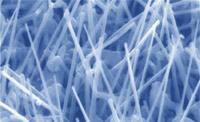More Power to Electronics Thanks to Nano-scale Wires
 Today a long-standing electronic dream has become a reality thanks to research done by a team of scientists from Bar-Ilan University, Israel, supported by U.S. Department of Energy’s (DOE) at Brookhaven National Laboratory. Producing superconducting nano-scale wires to facilitate faster and more powerful electronic devices has been the long-time ambition which had eluded achievement until now.
Today a long-standing electronic dream has become a reality thanks to research done by a team of scientists from Bar-Ilan University, Israel, supported by U.S. Department of Energy’s (DOE) at Brookhaven National Laboratory. Producing superconducting nano-scale wires to facilitate faster and more powerful electronic devices has been the long-time ambition which had eluded achievement until now.Difficulty conquered:
Until today superconductor’s coherence length size needed to be large and very thin wires were not successful superconductors. But the research has shown that small-size coherence lengths can be successfully used both within the layered copper-oxide superconductors and out-of-plane, the coherence length can be even less. The other plus point was that they worked in warmer temperatures, circumventing the costly cooling process.
Taking another step forward:
The Brookhaven team tried to transpose the same superconductivity onto a thin film material by etching the pattern of wires and create layered superconducting thin films. Using molecular beam epitaxy, they are building a material made of alternate copper-oxide layers and lanthanum and strontium. This technique has been successfully used previously to fabricate superconductivity-retaining thin films within one copper-oxide layer.
The new material spells success:
The team ‘etched’ thousands of loops in a pattern by using electron-beam lithography. All these loops of ‘nano-wires’ were only 25 nano-meter diameter width and 150-500 nano-meter long. These arrays with the loop pattern were cooled to below about 30K and were found superconducting which was shown by the electrical resistance shown by the arrays. They tried how the loop resistance will change with external magnetic fields.
With yet another plus quality:
Another feature that came to light which delighted the scientists was the fact that there was oscillation-type change in resistance with the introduction of external magnetic field. The large-amplitude-oscillation frequencies corresponded to the different units of magnetic field strength that were acting on the loops.
More useful than ever:
In Brookhaven Lab physicist, Bosovic’s words, “A material with such a discrete, switchable form of magneto-resistance — especially from the superconducting to the non-superconducting state — could be extremely useful for engineering new devices.” Ivan Bozovic and his team’s work – a result of German-Israeli cooperation – was funded by German Research Foundation with a scholarship grant by Israel Ministry of Science.
Hope for future:
This research can lead to understand the mechanism of superconductivity better which will lead to more advanced designs of new materials for many other practical applications.
To see how Klean Industries is producing high-grade carbon nanotube and carbon nano wires of all sizes please visit Klean Carbon by clicking here.
You can return to the main Market News page, or press the Back button on your browser.

